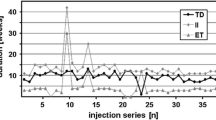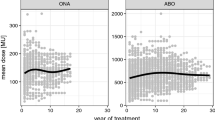Abstract
Results from a dose-ranging study in a selected group of de novo patients with rotational cervical dystonia (CD) suggest that 500 units of Dysport (Clostridium botulinum toxin type A haemaglutinin complex) is the optimal starting dose. The present study aimed to confirm the efficacy and safety profile of this dose in a population of CD patients more representative of those seen in a typical dystonia clinic.
A total of 68 patients with moderate to severe CD (Tsui score ≥ 9) were randomly assigned to receive placebo or Dysport 500 units. Treatment was administered according to the clinical pattern of head deviation, using a standardised injection protocol. A total of 21 patients (11 Dysport, 10 placebo) had not previously received botulinum toxin type A (BtxA) injections, and 47 patients (24 Dysport, 23 placebo) had received BtxA more than 12 weeks previously. Assessments were performed at baseline and weeks 4, 8 and 16. Patients defined as non-responders at week 4 were re-treated in an open phase with 500 units of Dysport at week 6, and were followed up at week 10.
Significant between-group differences in Tsui scores were present at weeks 4 (p=0.001) and 8 (p=0.002). Similarly, there were significant between-group differences (p < 0.001) in patient and investigator assessments of response in favour of Dysport at weeks 4 and 8. Also, more Dysport (49 %) than placebo (33 %) patients were pain-free at week 4 (p=0.02). Overall, 30/35 (86 %) Dysport patients and 14/33 (42 %) placebo patients were classified as responders at week 4. Adverse events were reported by 15/35 Dysport patients and 9/33 placebo patients. Open phase treatment produced improvements in Tsui (p < 0.001) and pain scores (p=0.011), and 23/24 patients were classified as responders.
Although individual dose titration and muscle selection is desirable, this study demonstrated that a dose of 500 units of Dysport injected into clinically identified neck muscles without electromyographic guidance is safe and effective in the treatment of patients with the major clinical types of cervical dystonia.
Similar content being viewed by others
Author information
Authors and Affiliations
Additional information
Received: 3 October 2000, Received in revised form: 20 March 2001, Accepted: 2 May 2001
Rights and permissions
About this article
Cite this article
Wissel, J., Kanovsky, P., Ruzicka, E. et al. Efficacy and safety of a standardised 500 unit dose of Dysport® (Clostridium botulinum toxin type A haemaglutinin complex) in a heterogeneous cervical dystonia population: results of a prospective, multicentre, randomised, double-blind, placebo-controlled, parallel group study. J Neurol 248, 1073–1078 (2001). https://doi.org/10.1007/s004150170028
Issue Date:
DOI: https://doi.org/10.1007/s004150170028




